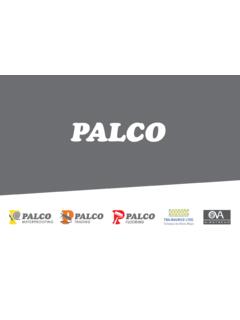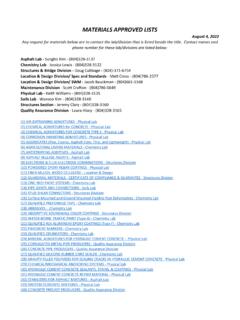Transcription of Standard Specification for Mortar for Unit Masonry1
1 Designation: C270 10 Standard Specification forMortar for Unit Masonry1 This Standard is issued under the fixed designation C270; the number immediately following the designation indicates the year oforiginal adoption or, in the case of revision, the year of last revision. A number in parentheses indicates the year of last reapproval. Asuperscript epsilon ( ) indicates an editorial change since the last revision or Standard has been approved for use by agencies of the Department of Scope* This specification covers mortars for use in the construc-tion of non-reinforced and reinforced unit masonry types of Mortar are covered in each of two alternativespecifications: (1) proportion specifications and (2) When the property specification is used to qualify masonrymortars, the testing agency performing the test methods should beevaluated in accordance with The proportion or property specifications shall govern When neither proportion or property specifications arespecified, the proportion specifications shall govern, unlessdata are presented to and accepted by the specifier to show thatmortar meets the requirements of the property The text of this specification references notes andfootnotes which provide explanatory material.
2 These notes andfootnotes (excluding those in tables and figures) shall not beconsidered as requirements of the The terms used in this specification are identified The values stated in inch-pound units are to be regardedas Standard . The values given in parentheses are mathematicalconversions to SI units that are provided for information onlyand are not considered The following safety hazards caveat pertains only to thetest methods section of this specification:This Standard doesnot purport to address all of the safety concerns, if any,associated with its use. It is the responsibility of the user of thisstandard to establish appropriate safety and health practicesand determine the applicability of regulatory limitations priorto Referenced Standards:2C5 Specification for Quicklime for Structural PurposesC91 Specification for Masonry CementC109/C109 MTest Method for Compressive Strength ofHydraulic Cement Mortars (Using 2-in.)
3 Or [50-mm] CubeSpecimens)C110 Test Methods for Physical Testing of Quicklime,Hydrated Lime, and LimestoneC128 Test Method for Density, Relative Density (SpecificGravity), and Absorption of Fine AggregateC144 Specification for Aggregate for Masonry MortarC150 Specification for Portland CementC188 Test Method for Density of Hydraulic CementC207 Specification for Hydrated Lime for Masonry Pur-posesC305 Practice for Mechanical Mixing of Hydraulic CementPastes and Mortars of Plastic ConsistencyC511 Specification for Mixing Rooms, Moist Cabinets,Moist Rooms, and Water Storage Tanks Used in theTesting of Hydraulic Cements and ConcretesC595 Specification for Blended Hydraulic CementsC780 Test Method for Preconstruction and ConstructionEvaluation of Mortars for Plain and Reinforced UnitMasonryC952 Test Method for Bond Strength of Mortar to MasonryUnitsC979 Specification for Pigments for Integrally ColoredConcreteC1072 Test Method for Measurement of Masonry FlexuralBond StrengthC1093 Practice for Accreditation of Testing Agencies forMasonryC1157 Performance Specification for Hydraulic CementC1180 Terminology of Mortar and Grout for Unit Masonry1 This specification is under the jurisdiction of ASTM CommitteeC12onMortars and Grouts for Unit Masonry and is the direct responsibility of Specifications for edition approved June 1, 2010.
4 Published July 2010. Originally approvedin 1951. Last previous edition approved in 2008 as C270 08a. DOI: referenced ASTM standards, visit the ASTM website, , orcontact ASTM Customer Service at ForAnnual Book of ASTMS tandardsvolume information, refer to the Standard s Document Summary page onthe ASTM *A Summary of Changes section appears at the end of this ASTM International, 100 Barr Harbor Drive, PO Box C700, West Conshohocken, PA 19428-2959, United States. Copyright by ASTM Int'l (all rights reserved); Tue Aug 3 12:10:48 EDT 2010 Downloaded/printed byRobert wildman (masonry+institute+of+washington) pursuant to License Agreement. No further reproductions of MasonryC1324 Test Method for Examination and Analysis of Hard-ened Masonry MortarC1329 Specification for Mortar CementC1357 Test Methods for Evaluating Masonry BondStrengthC1384 Specification for admixtures for Masonry MortarsC1489 Specification for Lime Putty for Structural PurposesC1506 Test Method for Water Retention of HydraulicCement-Based Mortars and PlastersC1586 Guide for Quality Assurance of MortarsE72 Test Methods of Conducting Strength Tests of Panelsfor Building ConstructionE514 Test Method for Water Penetration and LeakageThrough MasonryE518 Test Methods for Flexural Bond Strength of Industry Council:3 Hot and Cold Weather Masonry Construction Manual, Janu-ary 19993.
5 Specification Specification C270 isnota specification to determinemortar strengths through field Laboratory testing of Mortar to ensure compliance withthe property specification requirements of this specificationshall be performed in accordance The propertyspecification of this Standard applies to Mortar mixed to aspecific flow in the The compressive strength values resulting from fieldtested mortars do not represent the compressive strength ofmortar as tested in the laboratory nor that of the Mortar in thewall. Physical properties of field sampled Mortar shall not beused to determine compliance to this specification and are notintended as criteria to determine the acceptance or rejection ofthe Mortar (see Section8).4. Materials used as ingredients in the Mortar shall con-form to the requirements specified Materials Cementitious materials shallconform to the following ASTM Cement Types I, IA, II, IIA, III, IIIA, orV of Hydraulic Cements Types IS(<70),IS(<70)-A, IP, IP-A of Cements Types GU, HE, MS, HS, MH,and LH of Blast-Furnace Slag Cement (for Use inProperty Specifications Only) Types IS($70) or IS($70)-Aof Cement See Cement See See Lime SpecificationC207, Types S orSA.
6 Types N or NA limes are permitted if shown by test orperformance record to be not detrimental to the soundness ofthe Putty See See Water shall be clean and free of amounts ofoils, acids, alkalies, salts, organic materials, or other substancesthat are deleterious to Mortar or any metal in the admixtures shall not be added to mortarunless specified. admixtures shall not add more than 65 ppm( %) water soluble chloride or 90 ppm ( %) acidsoluble chloride to the Mortar s overall chloride content, unlessexplicitly provided for in the contract admixtures admixtures which are clas-sified as bond enhancers, workability enhancers, set accelera-tors, set retarders, and water repellents shall be in accordancewith Pigments Coloring pigments shall be inaccordance with admixtures Mortars containing ad- mixtures outside the scopes of SpecificationsC1384andC979shall be in accordance with the property requirements of thisspecification and the admixture shall be shown to be non-deleterious to the Mortar , embedded metals, and the Chloride When explicitly provided for inthe contract documents, calcium chloride is permitted to beused as an accelerator in amounts not to exceed 2 % by weightof the portland cement content or 1 % of the masonry cementcontent, or both, of the If calcium chloride is allowed.
7 It should be used with cautionas it may have a detrimental effect on metals and on some wall Unless otherwise stated, a cement/lime Mortar , a mortarcement Mortar , or a masonry cement Mortar is permitted. Amortar type of known higher strength shall not be indiscrimi-nately substituted where a Mortar type of anticipated lowerstrength is Specifications Mortar conforming to theproportion specifications shall consist of a mixture of cemen-titious material, aggregate, and water, all conforming to therequirements of Section4and the proportion specifications requirements ofTable 1. SeeAppendix X1orAppendix X3fora guide for selecting masonry Specifications Mortar conformance to theproperty specifications shall be established by tests of labora-tory prepared Mortar in accordance with Thelaboratory prepared Mortar shall consist of a mixture ofcementitious material, aggregate, and water, all conforming tothe requirements of Section4and the properties of thelaboratory prepared Mortar shall conform to the requirementsofTable 2.
8 SeeAppendix X1for a guide for selecting No change shall be made in the laboratory establishedproportions for Mortar accepted under the property specifica-tions, except for the quantity of mixing water. Materials with3 Available from the Mason Contractors Association of America, 1910 SouthHighland Avenue, Suite 101, Lombard, IL 102 Copyright by ASTM Int'l (all rights reserved); Tue Aug 3 12:10:48 EDT 2010 Downloaded/printed byRobert wildman (masonry+institute+of+washington) pursuant to License Agreement. No further reproductions physical characteristics shall not be utilized in themortar used in the work unless compliance with the require-ments of the property specifications is The physical properties of plastic and hardened mortarcomplying with the proportion specification ( ) may differ from thephysical properties of Mortar of the same type complying with theproperty specification ( ).
9 For example, laboratory prepared mortarsbatched to the proportions listed inTable 1will, in many cases,considerably exceed the compressive strength requirements ofTable The required properties of the Mortar inTable 2are forlaboratory prepared Mortar mixed with a quantity of water to produce aflow of 11065 %. This quantity of water is not sufficient to produce amortar with a workable consistency suitable for laying masonry units inthe field. Mortar for use in the field must be mixed with the maximumamount of water, consistent with workability, in order to provide sufficientwater to satisfy the initial rate of absorption (suction) of the masonry properties of laboratory prepared Mortar at a flow of 11065, asrequired by this specification, are intended to approximate the flow andproperties of field prepared Mortar after it has been placed in use and thesuction of the masonry units has been satisfied.
10 The properties of fieldprepared Mortar mixed with the greater quantity of water, prior to beingplaced in contact with the masonry units, will differ from the propertyrequirements inTable 2. Therefore, the property requirements inTable 2cannot be used as requirements for quality control of field preparedmortar. Test MethodC780may be used for this Air content of non-air-entrained portland cement-lime mortaris generally less than 8 %.6. Test of Materials for Test Specimens Laboratory mixed Mortar used for determining conformance tothis property specification shall contain construction materialsTABLE 1 Proportion Specification RequirementsNOTE Two air-entraining materials shall not be combined in by Volume (Cementitious Materials)MortarTypePortlandCement orBlendedCementMortar CementMasonry CementHydrated Limeor Lime PuttyAggregate Ratio(Measured inDamp, Loose Con-ditions)MSNMSNC ement-LimeM1.



